This shrimp fried rice uses rice, raw shrimp, sesame oil, scrambled eggs, and more. Easily personalize it with your own blend of favorite veggies!

Making Shrimp Fried Rice
All you need for a delicious shrimp fried rice dinner is 10 minutes of prep time and 15 minutes to cook. Prepare the rice and shrimp ahead of time to make it even quicker.
- Season the shrimp: In a small bowl, season the shrimp with cornstarch and salt.
- Sauté the shrimp: In a preheated wok with oil, sauté the shrimp on both sides until lightly golden. Then, remove from the wok.
- Cook the eggs: In a medium sized bowl, whisk the eggs. Then, scramble the eggs in the wok until they’re no longer runny. Remove from the pan and set aside.
- Stir the rice: Add rice and cook without mixing. After three minutes, stir and cook for an additional two minutes.
- Combine all the ingredients: Add soy sauce and sesame oil to the rice to combine. Then add eggs, cooked shrimp, and green onions. Toss, then enjoy!




Tips from the Kitchen
When the craving for shrimp fried rice hits, you don’t have to pay for takeout. For fried rice with the best texture and flavor, follow these tips.
- Leave space between shrimp: When sauteéing, avoid overcrowding the shrimp. To get a tasty sear, leave a little bit of space between the shrimp.
- Avoid overcooking: Shrimp is easy to overcook, so cook until they just turn opaque pink. Once pink, promptly remove from heat.
- Opt for low sodium soy sauce: To avoid the fried rice from being too salty, use low sodium soy sauce. It’s easier to add extra salt later rather than deal with an overly salty dish.
- Only use cold rice: The key to fluffy fried rice is to use cold rice — especially leftover rice. Avoid using freshly cooked rice as it turns sticky and gooey in the pan.
- Adjust the amount of soy sauce: Adjust the amount of soy sauce according to your liking. Always start with less, then gradually increase as preferred. If you add a lot of additional ingredients, more soy sauce may be needed as well.
- Use a wok: Fried rice is best made in a wok. Cooked food gets pushed up the sides of the wok as it cooks, while the uncooked food remains cooking on the bottom. In a pinch, use a skillet — however, pay attention so as not to overcook the dish.
- Cook on high heat: Cook the fried rice over high heat for the best results. This will help each ingredient keep its texture instead of turning to mush.

Mix-Ins & Substitutions
A perk of fried rice is how easy it is to personalize according to your cravings and/or access to ingredients. Try one of these ideas, or try them all! Let us know what your favorite combination is in the comments below!
- Vegetables: What’s a stir fry without vegetables? Add in your favorite stir fry veggies including frozen peas, cauliflower, corn, broccoli, sugar snap peas, minced garlic, and carrots.
- Protein: Combine the best of two worlds by adding chicken and shrimp together in one ultimate fried rice meal. Sauté the chicken separately until cooked through and golden brown and mix in with the cooked shrimp. Add bacon bits for even more protein and flavor!
- Sauce: Swap out the soy sauce with coconut aminos. Coconut aminos have a milder, sweeter flavor with less salt. For a sesame oil alternative, use peanut oil, grapeseed oil, or any other oil you love.
- Rice: Use almost any type of rice you have on hand. White rice, basmati long-grain rice, or brown rice all work well. Avoid sushi rice as it becomes clumpy when fried.
- Ginger: For more asian flavor, add half a teaspoon of ground ginger.
Ways to Serve
Shrimp fried rice is an entire meal by itself. The shrimp covers the protein aspect of a meal, rice is the carbohydrate, and the added veggies provide loads of vitamins and nutrients. The only thing left is a drizzle of spicy mayo or yum yum sauce on top for more flavor.
If you’re looking for additional entrees or side dishes to pair with the fried rice, look no further. As an appetizer, serve spring rolls with salmon or gyoza. For more protein, make a large batch of sweet and sour chicken. When you’re craving a soup, make a bowl of wonton soup.
Storage Tips + Reheating
We love making extra shrimp fried rice in order to have leftovers for lunch during the week. The fried rice stores well and tastes just as good reheated as when it was first made.
- Refrigerator: To store for up to four days in the fridge, scoop the rice into an airtight container and keep in the fridge.
- Freezer: To freeze for up to three months, place fried rice into an airtight, freezer-safe container. Fried rice is a great freezer meal. Thaw it in the fridge before serving.
- Reheating: To reheat for the best texture and flavor, place the fried rice back into a pan or skillet and warm over medium high heat. Add a splash of water and stir to add more moisture when the rice is dry.
FAQ
What is the difference between Japanese fried rice, Chinese fried rice, and Thai fried rice?
Japanese, Chinese, and Thai fried rice differ slightly in the type of ingredients used — most notably the type of rice. Japanese typically uses short grain rice, Chinese uses long grain rice, and Thai fried rice often uses jasmine rice.
Why do some fried rice recipes call for vinegar?
Vinegar is a popular ingredient used in Chinese cuisine, so some fried rice recipes call for vinegar as well. The vinegar adds a slight tangy taste to the dish.
Why is my fried rice soggy?
Fried rice can turn out soggy if warm, moist rice is used and the dish was cooked on low heat. Avoid this by cooking the rice on high heat and using cold rice.
More Asian Take-Out Dishes
- Egg Roll in a Bowl – Easy, deconstructed egg roll made with ground beef
- Sushi Bake – Made with salmon, this is so much easier than rolling sushi!
- Yakisoba Noodles – Simple Japanese sweet and sour noodles
- Beef and Broccoli – One-pan classic takeout dish
- Beef Lo Mein – Stir fried egg noodles with strips of beef
- Spicy Chili Noodles – Tangy and spicy noodles made with chili flakes
- Young Chow Fried Rice – Multiple proteins in this easy fried rice
Recipe
Ingredients
- 1 lb raw shrimp deveined and peeled
- 1 tsp cornstarch
- 1 tsp salt
- 2 tbsp oil olive or avocado
- 4 large eggs beaten
- 5 cups cooked white rice
- 3 tbsp soy sauce low sodium
- 1 tbsp sesame oil
- 1/3 cup green onion chopped
Instructions
- Place shrimp in a bowl, toss with cornstarch and salt.
- Preheat a wok with one tablespoon of oil. Add the shrimp and sauté on both sides until lightly golden. Remove and set aside.
- In a medium sized bowl, whisk eggs until perfectly smooth. Scramble eggs in the same pan or wok used to cook shrimp, just until no longer runny. Remove eggs from the wok, set aside.
- Add remaining tablespoon of oil to the pan, then add rice and cook for three minutes without mixing. Stir the rice and cook for an additional two minutes.
- Add soy sauce and 1 tbsp sesame oil. Stir to combine together. Add in cooked eggs, shrimp, and green onion. Toss together and enjoy!
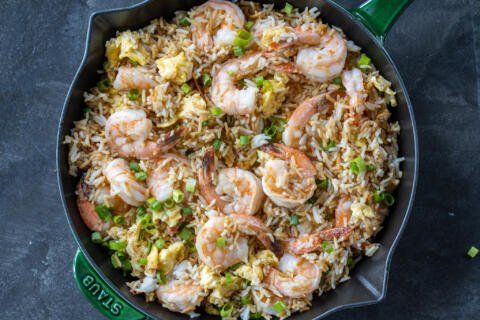
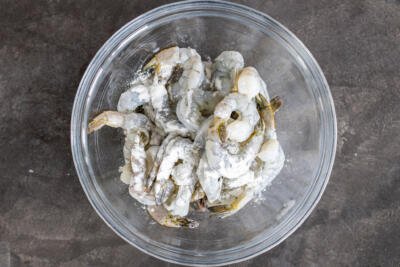

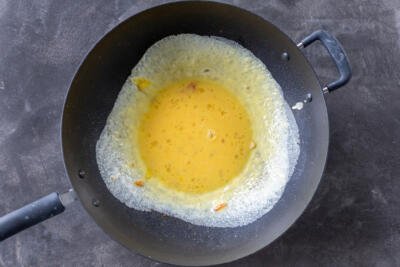

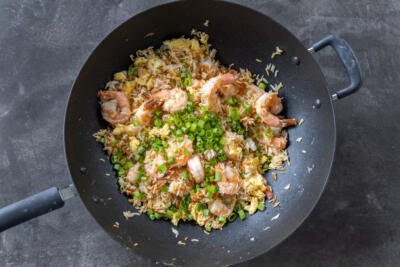
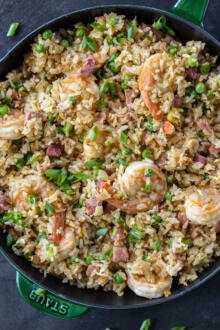
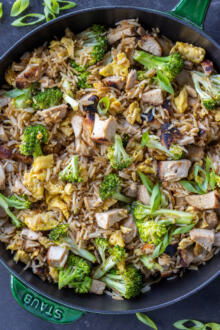

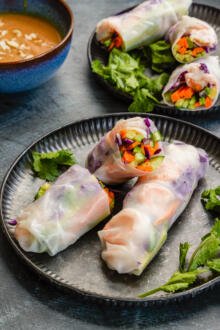
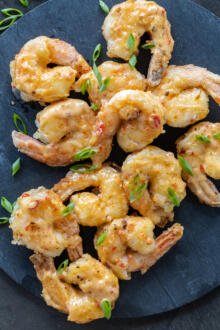
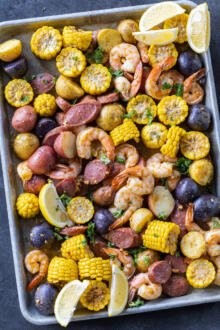
Hi, do I pre-cook the rice?
Hi Sherry, Yes, pre-cook the rice and it's best to use cold rice! I hope this helps.
Just checking - equal amount of cornstarch and salt? 1 teaspoon of each?
Hi Valeria, That is correct - one teaspoon of each. Enjoy!